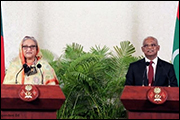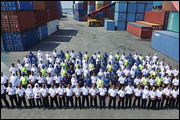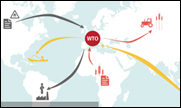Trade Facilitation Results
Trade facilitation focuses on removing barriers to the international movement of goods to lower trade costs, at and around the borders, and along the supply chain, to make countries more competitive in regional and global markets. In the SASEC subregion, bottlenecks in trade facilitation are the leading non-tariff barriers that constrain intraregional trade. SASEC initiatives in trade facilitation aims to make cross-border trade and transport in the subregion faster, cheaper, and more predictable, while maintaining the security of the supply chain and ensuring the effectiveness and efficiency of the institutions involved.
TRANSPORT MALDIVES
NEWS & MULTIMEDIA
total items: 16Bangladesh Prime Minister Sheikh Hasina and Maldives President Ibrahim Mohamed Solih held bilateral talks on 23 December 2021 at the President’s Office in Malé, Maldives. They discussed matters of mutual interest and emphasized the importance of signing a Preferential Trade Agreement.
Bangladesh is looking to produce resort wear and leisure apparel for Maldives. Mr. Faruque Hassan, President of BGMEA discussed the potential of tapping this Maldives market with Mr. Shiruzimath Sameer, Bangladesh High Commissioner to Maldives.
The Government of Maldives has signed a $10 million project with the Asian Development Bank (ADB) for its National Single Window Project. The agreement was signed at the sidelines of the Maldives Partnership Forum by Finance Minister Ibrahim Ameer and Mr. Ronald Butiong, Director for Regional Cooperation and Operations Coordination, South Asia Department, ADB.
The Asian Development Bank approved the proposed financing for the Maldives: SASEC National Single Window Project worth $11 million. This project will introduce a single electronic platform in Maldives to improve the speed and efficiency of cross-border control procedures by employing the latest technology. This project will improve the trade environment of Maldives, and help expand its trade with partners in the region, including India and Sri Lanka.
Mr. Wencai Zhang, Vice President, Asian Development Bank (ADB), encouraged the active participation of Maldives in regional cooperation programs, in his two-day visit to Male, Maldives. ADB plans to increase support for Maldives in 2018-2019 through its indicative investment program that focuses on developing the Greater Male region, and also includes the SASEC National Window Project.
Bangladesh has the potential to become a transport hub for India, Bhutan, Nepal, Maldives, Sri Lanka, and Myamar, according to Mr. AMA Muhith, Finance Minister, Bangladesh. Turning Bangladesh into a regional and transshipment hub would enhance economic cooperation and result in collective economic growth for the countries, Mr. Muhith said at the SASEC Finance Ministers’ Meeting in New Delhi, India.
The Directorate of Revenue Intelligence under the Central Board of Excise and Customs organized the 4th Regional Customs Enforcement Meeting in New Delhi, India, as part of its Founding Day celebrations. The Heads of Customs Enforcement from Sri Lanka, Myanmar, Bangladesh, Nepal, Bhutan, Mauritius and Maldives were invited to participate in the said Meeting, which discussed issues of mutual concern, noted the need to share information and activate channels of coordination.
EPing, an online alert system for updates on the latest information on regulatory requirements for international trade, was launched by the United Nations Department of Economic and Social Affairs, the World Trade Organization, and the International Trade Centre. The system enables access to WTO member notifications on TBT and SPS measures, and facilitates dialogue among the public and private sector in the early stages of potential trade issues.
Finance Ministers from the eight South Asian Association for Regional Cooperation (SAARC) member states are pushing for the formation of a South Asian Economic Union (SAEU) to ensure larger inflow of investments, higher trade volumes, and energy generation. The ministers highlighted the need to fast-track the formation of the SAEU to help boost the inflow of investments and trade volumes.
South Asia Subregional Economic Cooperation (SASEC) investment projects increased to a cumulative $7.66 billion in the areas of transport, energy, trade facilitation, and ICT with the recent approval of India’s Bihar New Ganga Bridge Project. To date, 40 SASEC-supported projects are helping member countries strengthen regional connectivity infrastructure, promote economic growth, and foster regional cooperation. In addition, there are now 71 technical assistance projects worth $66.14 mi
Mr. Hun Kim, Director General, South Asia Department, ADB, describes how partnership of 6 South Asian countries through the ADB-supported South Asia Subregional Economic Cooperation (SASEC) Program is helping propel economic growth in South Asia, amidst an uncertain regional and global economic climate, by working to increase trade volumes to reduce the number of impoverished people in the region.
Bangladesh, Bhutan, India and Nepal (BBIN) signed a landmark Motor Vehicles Agreement (MVA) meant to allow smooth passage of goods and passenger vehicles in each other’s territories. In this blog post, Sanjay Kathuria, Lead Economist and Coordinator, South Asia Regional Integration, Trade and Competitiveness Global Practice, World Bank, asks if South Asia is truly ready for such a regional agreement.
The interactive SASEC Corridor Map on the SASEC Program website and SASEC Mobile App is your gateway to SASEC projects. View projects by sector—energy, transport, trade facilitation, and ICT—or by corridor using the interactive map, to learn how the SASEC program is helping promote regional prosperity in South Asia. The map also includes project information and links to SASEC project pages.
Meetings between Customs officials from SASEC member countries reaps benefits for the SASEC subregion and beyond, providing a platform for officers to decide the next steps in improving cross-border coordination and cooperation to resolve bottlenecks for trade at the borders. An Asian Development Bank (ADB) blog post by Ms. Rose McKenzie, Senior Regional Cooperation Specialist, Regional Cooperation and Operations Coordination, South Asia Regional Department, ADB, is shared.
Dr. Selim Reihan notes that drivers of political economy can impact the region's integration agenda. In this essay, Dr. Raihan highlights the importance of exploring the political economy of regional integration to generate a better assessment of the factors driving and constraining regional integration, and create broader awareness among stakeholders to stimulate a more realistic and effective regional policy design and processes.
South Asia is set to play a strategic role in Asian integration. This commentary by Mr. Ganeshan Wignaraja, Advisor in the Asian Development Bank’s Economic Research and Regional Cooperation Department, shares how linking emerging South Asia with the more developed member countries of the Association of South East Asian Nations will transform regional economies through development of regional connectivity, and create a huge regional market of 2-3 billion people.
















